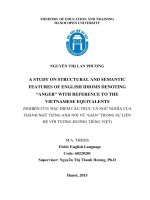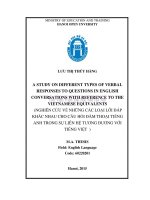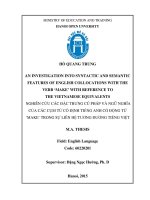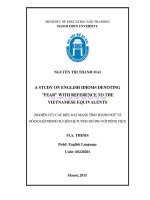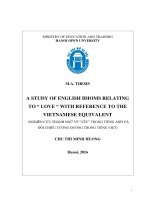A study of english politeness strategies for expressing annoyance with reference to the vietnamese equivalents
Bạn đang xem bản rút gọn của tài liệu. Xem và tải ngay bản đầy đủ của tài liệu tại đây (900.13 KB, 78 trang )
MINISTRY OF EDUCATION AND TRAINING
HANOI OPEN UNIVERSITY
M.A. THESIS
A STUDY OF ENGLISH POLITENESS STRATEGIES FOR
EXPRESSING ANNOYANCE WITH REFERENCE TO THE
VIETNAMESE EQUIVALENTS
(NGHIÊN CỨU CHIẾN LƯỢC LỊCH SỰ BÀY TỎ SỰ KHÓ CHỊU TRONG
TIẾNG ANH LIÊN HỆ VỚI TƯƠNG ĐƯƠNG TIẾNG VIỆT)
LÊ THỊ TUYẾT HƯỜNG
Hanoi, 2016
LÊ THỊ TUYẾT HƯỜNG
ENGLISH LINGUIAGE
2014 - 2016
MINISTRY OF EDUCATION AND TRAINING
HANOI OPEN UNIVERSITY
M.A. THESIS
A STUDY OF ENGLISH POLITENESS STRATEGIES FOR
EXPRESSING ANNOYANCE WITH REFERENCE TO THE
VIETNAMESE EQUIVALENTS
(NGHIÊN CỨU CHIẾN LƯỢC LỊCH SỰ BÀY TỎ SỰ KHÓ CHỊU TRONG
TIẾNG ANH LIÊN HỆ VỚI TƯƠNG ĐƯƠNG TIẾNG VIỆT)
LÊ THỊ TUYẾT HƯỜNG
Field: English Language
Code: 60220201
Supervisor: Dr. MAI THỊ LOAN
Hanoi, 2016
CERTIFICATE OF ORIGINALITY
I, the undersigned, hereby certify my authority of the study project report entitled
A study of English politeness strategies for expressing annoyance with reference to
the Vietnamese equivalents submitted in partial fulfillment of the requirements for
the degree of Master in English Language. Except where the reference is indicated,
no other person’s work has been used without due acknowledgement in the text of
the thesis.
Hanoi, 2016
Le Thi Tuyet Huong
Approved by
SUPERVISOR
(Signature and full name)
Date:……………………
ACKNOWLEDGEMENTS
This thesis could not have been completed without the help and support from a
number of people.
First and foremost, I would like to express my sincere gratitude to Dr. Mai Thi
Loan, my supervisor, who has patiently and constantly supported me through the
stages of the study, and whose stimulating ideas, expertise, and suggestions have
inspired me greatly through my growth as an academic researcher.
A special word of thanks goes to teachers and students in Faculty of English at
Hanoi Open University and many others, without whose support and
encouragement it would never have been possible for me to have this thesis
accomplished.
Last but not least, I am greatly indebted to my family for the sacrifice they have
devoted to the fulfillment of this academic work.
ABSTRACTS
Cross-communication has been proved to be one of the most intriguing
issues that attracts the attention of many experts and researchers in Vietnam.
The fact that there are more studies conducted in almost all aspects of crosscommunication is the best evidence. Speech act, to be specific, is the matter of
interest that receives a distinguishable concern from many researchers.
Therefore, this study focused on the use of politeness strategies for
expressing annoyance in English with reference to the Vietnamese equivalents,
based on the solid theoretical background of pragmatics and cross-cultural
pragmatics. The author hopes that the similarities and differences in strategies
for expressing annoyance in English with reference to the Vietnamese
equivalents will contribute to the avoidance of cultural conflicts.
Data used for analysis in this study were collected through survey
questionnaires which consist of 2 main parts. The first part is to collect
informants’ parameters (age, gender, occupation and foreign language
acquisition). The second part consists of 3 situations given by the author to
collect the idea and attitude of Vietnamese and English informants when
expressing their annoyance according to their communicate partner (close
friend, acquaintance, colleague, boss and stranger).
The author has made this research with great interest and hoped that it will
be effective to the learners. However, mistakes and errors are unavoidable, all
comment and suggestions are highly appreciated.
LIST OF TABLES
page
Table 1: Realization of strategies used by Vietnamese and English informants
according to their age……………………………………………………………..45
Table 2: Realization of strategies used by Vietnamese and English informants
according to their gender ……………………………………………………........47
Table 3: Realization of strategies used by Vietnamese and English informants
according to their occupation………………………………………………….….48
Table 4: Realization of strategies used by Vietnamese and English informants
according to their language acquisition ………………………………………......50
Table 5: Realization of strategies used by Vietnamese and English informants
according to their communicative partners ………………………………………52
TABLE OF CONTENTS
Certificate of originality
i
Acknowledgements
ii
Abstract
iii
List of tables
iv
CHAPTER I: INTRODUCTION ....................................................................3
1. Rationale ................................................................................................3
2. Aims and objectives of the research ......................................................4
3. Scope of the research .............................................................................4
4. Methods of the research.........................................................................5
5. Significance of the research...................................................................5
6. Structure of Thesis .................................................................................6
CHAPTER II: THEORETICAL BACKGROUND........................................7
1. Review of the previous related studies ..................................................7
2. Culture and Communication..................................................................9
2.1 Culture ...........................................................................................10
2.2
Communication .............................................................................11
2.3
Culture- Communication correlation ............................................13
3. Cross- cultural pragmatics ...................................................................14
4. Speech acts ..........................................................................................15
4.1
4.2
Notions of Speech Acts .................................................................15
Classification of Speech Acts........................................................16
4.3
Direct and Indirect Speech Acts ....................................................18
4.4
Expressing annoyance as a speech act ..........................................19
5. Politeness .............................................................................................20
5.1
The notions of Politeness ..............................................................20
5.2 Politeness Strategies ......................................................................22
5.2.1 Bald-on- record ..............................................................................23
5.2.2. Positive politeness ........................................................................23
5.2.3 Negative politeness ........................................................................29
1
6. Summary ..............................................................................................35
CHAPTER III: METHODOLOGY ..............................................................36
1. Research questions ..............................................................................36
2. Data collection technique ....................................................................36
2.1. The questionnaire.............................................................................36
2.2. The informants .................................................................................37
3. Data analysis techniques......................................................................38
4. Summary ..............................................................................................38
CHAPTER IV: FINDING AND DISCUSSION ..........................................40
1. Realization of the strategies.................................................................40
1.1
Bald-on record ...............................................................................40
1.2
Hedging opinion ............................................................................42
1.3
Avoid giving opinion ....................................................................43
1.4
Joking ............................................................................................43
1.5
1.6
Telling a white-lie .........................................................................44
Give (or ask for reason).................................................................45
2 . Data analysis .........................................................................................46
2.1 Use of the strategies as seen from informants’ parameters ................46
2.2 Use of strategies in terms of communicative partners ........................52
3. Major cross-cultural similarities and differences between the English and the
Vietnamese .................................................................................................55
3.1 Similarities and differences as seen from informants’ parameters ......55
3.2 Similarities and differences in terms of communicative partners ......58
CHAPTER V: CONCLUSION.....................................................................61
1. Recapitulation ......................................................................................61
2. Concluding remarks.............................................................................61
3. Limitations of the current research ......................................................64
4. Suggestions for a further research .......................................................65
REFERENCES..............................................................................................66
2
CHAPTER I: INTRODUCTION
1.
Rationale
Language is very important for international communication nowadays. An
emphasis on language as a communication system is really necessary in an age
of globalization. Not only does it help uncover principles underlying social
interactions, but it also enables us to gain an access to ways of thinking, belief
systems, and world views of people from various cultural backgrounds and thus
enhances empathy and mutual understanding. Investigating issues concerning
cross-cultural communication is especially momentous in today’s time, when
national boundaries are becoming less visible, and more and more people are
engaging in intercultural communication. Understanding social conventions and
attention to such concepts as politeness, and face, which are important to
members in a particular culture, will certainly enable us to better comprehend
the different ways of speaking by people from different cultures, thus helping
eliminate ethnic stereotypes and misunderstandings.
Cross-cultural communication based on knowledge of many factors. It
describes the ability to successfully form, foster, and improve relationships with
members of a culture different from one’s own. We can realize cross-cultural
communication’s factors such as the other culture’s values, perceptions,
manners, social structure, decision-making practices. An understanding of how
members of the group communicate- both verbally and non- verbally, in person,
in writing or in any other kind of communication is also its factor.
Nevertheless, miscommunication is a very broad area, and with the world
becoming smaller and more diverse, miscommunication seems to be happening
3
more and more. As expressing annoyance is an act with high risk of making the
hearers lose face, it requires different supplementary steps to reduce the
weightiness of the utterance. That is the reason why expressing annoyance is
chosen for the project.
For any of those purposes, the author would like to spend time and effort to
provide a more comprehensive picture of the speech act of expressing
annoyance. The study promises to make itself meaningful, reliable and
applicable to the reality.
2.
Aims and objectives of the research
The thesis aims at helping Vietnamese learners of English to have a better
understanding of the strategies expressing annoyance and be able to use them in
daily communication.
With this aim, the thesis finds out the politeness strategies for expressing
annoyance in English and Vietnamese; compares and contrasts the
communicative strategies used by English and Vietnamese people when they
want to show their annoyance in verbal communication. Moreover, avoidance
of
cultural
conflicts
between
Vietnamese
and
English
leading
to
miscommunication is also its objective.
3.
Scope of the research
The data acquired from the survey questionnaire on ways of expressing
annoyance in English and Vietnamese is the study’s limitation. The answers
from informants are collected via email. Due to the time constraint and the
scope of a Minor Thesis, only 30 English informants were chosen for data
analysis with reference to Vietnamese equivalents.
4
The study also focus on the speech act of expressing annoyance only. Only
Vietnamese Northern dialect and English native speakers are chosen for
contrastive analysis. Social relationship is focused and the kinship between the
informants (speakers) and the communicative partners (hearers) is ignored in
this study. The informants were asked to express their annoyance to a certain
person only, not a thing or object.
4.
Methods of the research
The methods which are used in the research are interviewing English and
Vietnamese friends, colleagues and relatives; describing and analyzing of the
collected data; consulting with supervisor and discussing with the colleagues.
In addition, in order to set up the theoretical framework for the research,
the author refers to both Vietnamese and English publications.
5.
Significance of the research
(i) Theoretical significance
In terms of theoretical significance, the research is expected to contribute
an in-depth understanding of speech acts in English when expressing annoyance
with reference to the Vietnamese equivalents.
(ii) Practical significance
Cross- culturally compared and contrasted, the data has uncovered some
major similarities and differences in choosing politeness strategies to express
annoyance. It is the similarities and differences recognized that hopefully
5
contribute to the avoidance of cultural conflicts leading to communication
breakdown.
6.
Structure of Thesis
The thesis is designed with five chapters:
Chapter 1, Introduction shows rationale, aims, objectives of the research, scope
of the research, methods of the research, significance of the research and
organization structural of the research.
Chapter 2, Theoretical background provides an overview of the issues to be
covered and the situations in which the study is carried out.
Chapter 3, Methodology presents the research questions, the major methods,
the minor methods and the techniques employed in the research. The chapter
also describes the way the data are collected and analyzed.
Chapter 4, Finding and discussion describes and analyses the communicative
strategies used to express annoyance in English with reference to the
Vietnamese equivalents to find out and discuss the major cross-cultural
similarities and differences between the English and the Vietnamese
informants.
Chapter 5, Conclusion summaries the major findings found out from the
investigation and data analysis, presents the limitations of the study.
6
CHAPTER II: THEORETICAL BACKGROUND
1.
Review of the previous related studies
It cannot be denied that the expression of the annoyance is very easy to
make other lose face and impact on the relationship between the speaker and the
hearer. It is the reason why studying on expressing annoyance has drawn much
attention of researchers in many countries recently.
First of all, American Psychological Association (1999) conducted an
research on controlling anger. The authors indicated that anger is a completely
normal, usually healthy, human emotion. But when it gets out of control and
turns destructive, it can lead to many problems—problems at work, in personal
relationships, and in the overall quality of life. And it can make people feel as
though they are at the mercy of an unpredictable and powerful emotion. Some
brochures are meant by the author to help people understand and control anger.
Tiedens (2001) had a research on the effect of negative emotion expressions
on social status conferral. There are four studies examined status conferral. The
studies show that people confer more status to targets who express anger than to
targets who express sadness. In the first study, participants supported President
Clinton more when they viewed him expressing anger about the Monica
Lewinsky scandal than when they saw him expressing sadness about the
scandal. Studies 2-4 showed that anger expressions created the impression that
the expresser was competent and that these perceptions mediated the
relationship between emotional expressions and status conferral.
7
In 2005, Morris wrote an article about managing emotions in the work place.
The article examines the implications of this research for more effective
management of annoyance during service transactions. The rapid and
significant increase in the number of jobs which require regulated displays of
annoyance, as well as the potential impact of emotional displays on service
quality and customer satisfaction, certainly makes this issue one worthy of
additional attention.
Website wikiHow (2015) uploaded an article entitled How to express anger
without hurting people. This article was written by Jessica Casey. The author
divided the article into 4 part: Calming yourself down; Understanding your
anger; Talking about your emotions and Getting professional help. Through this
article, Jessica wants people to express their anger productively, calm
themselves down and work on understand their anger and other emotions. Then,
they can communicate their anger in an assertive manner that will be less likely
to hurt the other person.
In the context of Vietnam, Đỗ Thị Hồng Thùy (2010) had a study on joking
between friends and relatives in Vietnamese and English cultures. This study is
confined only to the verbal aspects of the act of joking. The author aims to
investigate the English- Vietnamese cross- cultural interaction on speech act of
joking between friends and relatives. The study’s central focus is on which
strategies used in joking in both languages English and Vietnamese.
Also in 2010, Ưng Thị Thu Quyên was concerned about AmericanVietnamese verbal expressions in offering a gift and responding to a gift offer.
This study compares and contrasts the strategies employed by Vietnamese and
8
American people when they offer a gift and respond to a gift offer in their own
language and culture.
Bùi Khánh Ly (2012) did a study on cognitive metaphors of negative
emotions in English and Vietnamese. Her study investigated cognitive
metaphors of three negative emotions: anger, sadness and fear in English and
Vietnamese based on the theory of cognitive semantics. The author discovered
and explained the similarities and differences in cognitive metaphors of the
three negative emotions in English and Vietnamese, especially in anger.
Nguyễn Thị Thùy Linh (2013) had a research on expressing satisfaction in
American English and Vietnamese. Her research aims to have a thorough
examination in the similarities and differences in directness and indirectness
strategies of expressing satisfaction be Vietnamese and English informants,
whereby to find out some similarities and differences in politeness strategies of
expressing satisfaction in English and Vietnamese.
2.
Culture and Communication
When two or more strangers from different cultures communicate or
exchange their information and attitude, they are doing intercultural or crosscultural communication, trying to show or let the other(s) learn about their
cultural values, norms, and beliefs. Since intercultural communication and
cross-cultural communication are not very much different and are used
interchangeably, we therefore would like to adopt the view of intercultural
communication as the exchange of information between individuals who are
unalike culturally. What is more, such communication is much influenced by
different factors, notably the binary system of competence-performance (what
9
one knows vs. what one does) and context (which sets the scene and shapes the
meaning that will attributed to what is said).
Cross-cultural or intercultural communication is simply defined as “the
exchange of information between individuals who are unalike culturally”
(Rogers and Steifatt 1999: 103) or “whenever a message producer is a member
of one culture and a message receiver is a member of another” (Samovar and
Porter, 1985: 39). In cross-cultural communication, people from different
cultures may not understand each other or get in trouble if they bring their
cultural values and norms into mutual exchanges. One of the typical examples
of cultural misunderstanding is that they transfer what is accepted in their
culture to new situation of communicating with others from a different culture.
This leads to not only serious misunderstanding, but also communication
breakdowns or fatal consequences. Nevertheless, it is not the common way for
many Vietnamese people to do the same job. Therefore, when contacting each
other, a Vietnamese and his Anglophone counterpart may have unexpectedly
negative comments on each other about the same act. According to Thomas
(1995), one of the reasons for communication failure is that interlocutors may
not have a good acquisition of the common language used in cross-cultural
communication.
2.1 Culture
Many intellectuals have defined the term “culture” until now. Culture
includes knowledge, belief, art, morals, law, custom and any other capabilities
and habits acquired by man as a member of society (Tylor,1974). Alternatively,
in a contemporary variant, culture is defined as a social domain that emphasizes
the practices, discourses, and material expressions, which, over time, express
10
the continuities and discontinuities of social meaning of a life held in common
(James,2010).
The definition of culture is wider than something people think, wear, eat, or
speak, etc… It is the everyday life, but in the humanities, one sense of culture,
as an attribute of the individual, has been the degree to which they have
cultivated a particular level of sophistication, in the arts, sciences, education, or
manners. The level of cultural sophistication has also sometimes been seen to
distinguish civilizations from less complex societies. Such hierarchical
perspectives on culture are also found in class-based distinctions between a high
culture of the social elite and a low culture, popular culture or folk culture of
the lower classes, distinguished by the stratified access to cultural capital.
2.2 Communication
According to Mckenzie (1997), communication is about transmitting ideas
or messages. Communication is the process of attempting to convey
information from a sender to a receiver with the use of a medium. There are
several means of communication. There are auditory means, such as speaking,
singing and sometimes tone of voice, and nonverbal, physical means, such as
body language, sign language, paralanguage, touch, eye contact, or the use of
writing. Communication is defined as a process by which we assign and convey
meaning in an attempt to create shared understanding. This process requires a
vast repertoire of skills in intrapersonal and interpersonal processing, listening,
observing, speaking, questioning, analyzing, and evaluating. Use of these
processes is developmental and transfers to all areas of life: home, school,
community, work, and beyond. It is through communication that collaboration
and cooperation occur. Communication is the articulation of sending a message,
11
through different media whether it be verbal or nonverbal, so long as a being
transmits a thought provoking idea, gesture, action, etc. We can understand that
communication is the process of exchanging information.
There is the definition from Hybels and Weaver (1992), which proposes
“Communication is any process in which people share information, ideas, and
feelings that involve not only the spoken and written words but also body
language, personal mannerism and style, the surrounding and things that add
meaning to a message”
Nonetheless, research by Birtwhisle in 1970 studied that communication is
usually described along a few major dimensions: Content (what type of things
are communicated), source, emisor, sender or encoder (by whom), form (in
which form), channel (through which medium), destination, receiver, target or
decoder (to whom), and the purpose or pragmatic aspect. Between parties,
communication includes acts that confer knowledge and experiences, give
advice and commands, and ask questions. These acts may take many forms, in
one of the various manners of communication. The form depends on the
abilities of the group communicating. Together, communication content and
form make messages that are sent towards a destination. The target can be
oneself, another person or being, another entity (such as a corporation or group
of beings). Communication can be seen as processes of information
transmission governed by three levels of semiotic rules:
Syntactic (formal properties of signs and symbols),
Pragmatic (concerned with the relations between signs/expressions and their users)
Semantic (study of relationships between signs and symbols and what they
represent).
12
Therefore, communication is social interaction where at least two interacting
agents share a common set of signs and a common set of semiotic rules.
Communication has been playing the primary role in our lives. It is a vital part
of personal life and is also important in business, education, and any other
situation where people encounter each other. Communication is required
everywhere.
2.3 Culture- Communication correlation
Culture
informs
communication.
It
brings
understanding
to
communication through a common background of shared experiences and
histories. The people of a unique culture usually share a geographic location as
well. This common geography also affects the unity of the group in that they
will all share the same experiences of weather and topography. Shared
experiences over hundreds or even thousands of years create culture that
contributes to understanding and communication.
Cross-cultural communication is a field of study that looks at how people
from differing cultural backgrounds communicate, in similar and different ways
among themselves, and how they endeavor to communicate across cultures.
Intercultural communication is a related field of study. It is a form of
communication that aims to share information across different cultures and
social groups. It is used to describe the wide range of communication processes
and problems that naturally appear within an organization or social context
made up of individuals from different religious, social, ethnic, and educational
backgrounds. Intercultural communication is sometimes used synonymously
with cross-cultural communication. In this sense it seeks to understand how
people from different countries and cultures act, communicate and perceive the
13
world around them. Many people in intercultural communication argue that
culture determines how individuals encode messages, what medium they
choose for transmitting them, and the way messages are interpreted.
3.
Cross- cultural pragmatics
The academic field of pragmatics offers a wide range of possible definitions
and does not provide clear-cut boundaries to the adjacent fields of semantics
and sociolinguistics. The often used definition of pragmatics as the study of
language use isn’t sufficient at all, so that one rather has to look what
pragmatists are doing, namely to study the interrelation of the structure of
language and the principles of the usage of language. A further definition
already comes quite close to the real meaning of pragmatics:
“Pragmatics is the study of those relations between language and context
that are grammaticalized, or encoded in the structure of a language.” (Levinson
1983: 9)
In the recent years, it came to a rising reaction against the universalism of
pragmatics, which claimed special pragmatic functions and modes to be
universal, accounting for every other language culture. As other cultures use
different languages which are underlying different traditions and values, their
pragmatic system, consequently, is likely to be different. Under that statement,
a new academic field was created, namely cross-cultural pragmatics. The main
concept is that in different cultural societies the members speak differently and
act differently. Such differences are based on different cultural values with the
speaking culture which may cause misunderstandings in communication with
other cultures. To avoid such misunderstandings, one has to analyze the
14
pragmatic nature of a distinct language by looking at the pragmatic functions
which are differently grammaticalized in different languages. Only in this
manner, one can try to make a comparison between the different pragmatic
natures of each language. Cross-cultural pragmatics isn’t important only for
comparing different cultures but also for general pragmatics as a whole.
General pragmatics is only able to phrase its theories with the help of crosscultural studies.
The variation of speech act is also one characteristic feature when describing
different languages. An example would be complementing, which is widely
spread in the English culture. If comparing Germans to British, the German
speakers are clearly more direct than the English. The character of speech acts
is dependent from each culture and the consequence would be the variation of
pragmatic validity within every culture.
4.
Speech acts
4.1 Notions of Speech Acts
There are all sorts of other things we can do with words such as making
requests, asking questions, giving orders, making promises, giving thanks,
offering apologies, etc... Moreover, almost any speech act is really the
performance of several acts at once, distinguished by different aspects of the
speaker's intention: there is the act of saying something, what one does in
saying it, such as requesting or promising, and how one is trying to affect one's
audience.
The theory of speech acts, according to Bach (1979), is partly taxonomic and
partly explanatory. It must systematically classify types of speech acts and the
15
ways in which they can succeed or fail. It must reckon with the fact that the
relationship between the words being used and the force of their utterance is
often oblique. For example, the sentence 'This is a pig sty' might be used
nonliterally to state that a certain room is messy and filthy and, further, to
demand indirectly that it be straightened out and cleaned up. Even when this
sentence is used literally and directly, say to describe a certain area of a
barnyard, the content of its utterance is not fully determined by its linguistic
meaning--in particular, the meaning of the word 'this' does not determine which
area is being referred to. A major task for the theory of speech acts is to account
for how speakers can succeed in what they do despite the various ways in which
linguistic meaning underdetermines use.
In general, speech acts are acts of communication. To communicate is to
express a certain attitude, and the type of speech act being performed
corresponds to the type of attitude being expressed. For example, a statement
expresses a belief, a request expresses a desire, and an apology expresses a
regret. As an act of communication, a speech act succeeds if the audience
identifies, in accordance with the speaker's intention, the attitude being
expressed.
4.2 Classification of Speech Acts
Speech acts are utterances that perform actions. Their focus is usually less
on their truth value than on their illocutionary effect, the effect that a speaker
wishes to have on his or her environment. The study of speech acts initially
focused on performative acts such as making a bet, naming a ship (or a person),
or declaring two people to be married (Flowerdew, 2013). However, no
utterance exists in a vacuum, and all speech can be considered to have
16
illocutionary effects. Therefore, the study of speech acts has broadened to
include more or less every kind of utterance, as well as the interpersonal aspects
of whole texts. A variety of methods exist for classifying speech acts based on
their illocutionary effects. Austin (1975) and Searle (1976) devised two wellknown taxonomies of speech act that are still used today to study the
interpersonal features of texts.
According to Austin, illocutionary acts can be classified into five types, i.e.,
verdictives, exercitives, commissives, behabitives, and expositives.
Verdictives: exercising judgment
Exercitives: exerting influence, exercising power
Commissives: assuming obligation, declaring intention
Behabitives: adopting attitude, expressing feeling
Expositives: clarifying reasons, argument, or communication
The second most influential person who took Austin’s words in caution and
revised his work is Searle (1976). For him, the illocutionary points include:
Representatives: Illocutionary acts that undertake to represent a state of
affaires.
Expressives: Illocutionary acts that express only the speaker’s
psychological attitude towards some state of affairs.
Directives: Illocutionary acts that S uses to get H to do something or
carry out some actions.
17
Commissives: Illocutionary acts that commit S to do something.
Declaratives: Illocutionary acts that bring about the state of affairs/ the
changes in the world via their utterance they refer to.
Though there are many other classifications proposed by other linguistics
such as Yule (1996:55), the classifications of Austin and Searle are the most
influential and noteworthy.
It can be said that Austin’s theory has laid basic and firm foundation for
Searle (1976) to present the clearest and most useful working classification of
speech acts.
4.3 Direct and Indirect Speech Acts
Sari (2009) indicated that a speaker performs a speech act with every
utterance. It can be a question (“Where is the car?”), a command (“Give me the
sweater!”), a statement (“Something smells bad in here.”), or a bunch of other
speech acts, like promises, threats, or requests.
In terms of speech acts, directness could be explained as matching the
speech act with the grammatical structure it most naturally takes. In the
examples above the question, the command, and the statement are all easily
recognizable, and can be interpreted at face value.
Asking direct questions from someone you are not that close with may make
the hearer feel you’re being nosy or intrusive. Furthermore, they might feel you
are forcing them to be rude by asking a question they cannot skate over and
must answer with a direct “I don’t want to tell you.”
18
